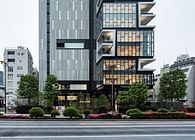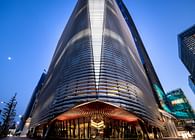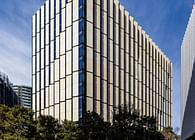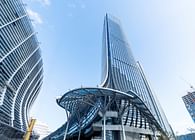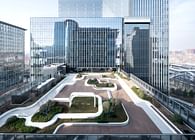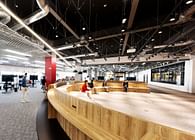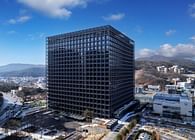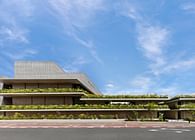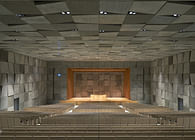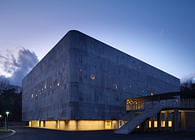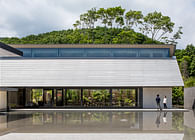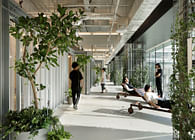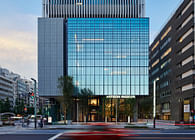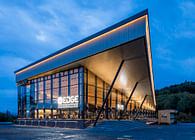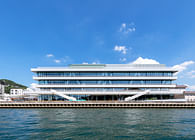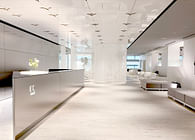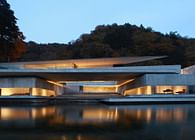
From former MOAT to FORT, and a new town center
This project site lies on the former outer moat of Edo Castle where the shogun lived. The bent section of the moat became the foundation of the current irregularly shaped city block, which was problematic in some respects, with its unusually configured intersection and lack of pedestrian space and greenery. Replacement of the district road and reorganization of the city block allowed for the creation of green plazas and comfortable walking spaces, and transformed the area into a high-rise complex of offices, SOHO, and shops.
The fact that the moat used to serve as the boundary between the daimyo (feudal lord)’s mansion and the residences of merchants and craftsmen is still clearly visible in the scale of the streetscape. Focusing on this difference, color precast concrete (PC) panels were used to create an exterior with a variety of expressions that combine both characteristics. The podium is connected to the plaza and sidewalks through an inner passageway that links pedestrian traffic. It also connects underground to the adjacent building and serves as the district node. The 11th floor Sky Lobby, which includes a rooftop garden and conference rooms, was created as a commons, with an open view to the surrounding area. The building’s design accommodates new work styles, and adds to the district’s value and sustainable development through its sanctuary role for persons affected by a major earthquake or disaster event. It also provides a centralized parking lot for small and medium-sized buildings in the neighborhood that are short of such spaces.
Volumes overlap in a staggered exterior
The former outer moat forms the boundary between Chiyoda ward, home to 100-meter skyscrapers, and Minato ward, where 50-meter buildings congregate. Focusing on this contrast, the height of Hibiya Fort Tower reflects the features of both districts, with a large division between upper and lower sections. The plan comprises a total of five volumes, each shifted to follow the shape of the moat site and superimposed on top of each other to form an exterior that looks like a cluster of buildings. Beige PC panels were used for the exterior to harmonize with the cityscape. The design showcases a total of seven different exterior design variations. The south facade of the tower -- the largest surface – is articulated by an exposed frame, with 2.8-meter-high PC eaves that block direct light and reduce the load on the air-conditioning system. The multiple façade exterior displays a different expression depending on the angle, while a sense of aesthetic unity is preserved with the use of horizontal, color PC panels.
The quarry-like Galleria
With its 12-meter-high ceiling, Hibiya Fort Tower’s lower-level Galleria connects the plazas on the east and west sides of the site. It is located in the same place where the former road was laid, enabling it to retain its role as a pedestrian throughway, and function as the main circulation axis for the new building as well as a public space open to the community. The Galleria is a vast space that resembles the massiveness and strength of the stone quarries and walls of the Imperial Palace that still stand today. Use of the same 7.2m x 1.8m large color PC panels for the interior allows for a visually integrated space that connects to the city. Brick-like floor tiles and galvanized steel ceiling louvers were also incorporated for their natural textures. With their slightly glossy finish, the louvers softly reflect the images of passing pedestrians and plaza greenery below, much like the reflective qualities of moat water.
Landscaping with individuality & a legacy-embracing wall
Each section of the 7,700 ㎡ site sports its own landscape appeal. The West Plaza features a piloti and square with abundant greenery at the building’s front. The East Plaza offers a relaxing, enriching space, with Oyamazakura (cherry blossom) trees at its center. With its sunken plaza and green space, it is positioned as the main public space in the district. A wall made of rust colored stone (from Inujima, an island in Japan’s Seto Inland Sea) was incorporated into the exterior landscape to honor the area’s history and moat legacy. A portion of the actual stone moat wall, excavated during construction, was also used as a landscape feature.
The Sky Lobby: a public space in the sky
The 11th floor Sky Lobby is located in between the differing upper and lower exterior sections, and easily accessible from the office floors. At a height of 60 meters, the space offers a spectacular view of Tokyo to the south. The facility is a value-adding public space outfitted with conference rooms, shops, and an outdoor garden. The floor is lowered by 400mm in the center to create a carpeted lounge with a water motif inspired by the moat and indoor greenery that stretches continuously from the garden. The area can be used as a waiting area, for business meetings, and as a space for office workers to refresh themselves.
A workplace that responds to new work styles
The core is spread from east to west, conforming to the contours of the site, and linearly aligned with the office space. This allows for a rectangular floor plan with good views. Two types of standard floor plans were prepared. For the lower-level offices (mainly used as the landowner’s headquarters), 24-meter-deep inner columns are positioned to maximize the workplace area, whereas mid-to-high level offices (occupied by tenants) feature 21.5-meter deep outer columns for flexibility. In the commons, the long east-west corridor is spacious and wide. Gender-neutral restrooms are provided with separate entrances for men and women. In addition, refreshment corners allow for the storage of emergency supplies.
Project name: HIBIYA FORT TOWER
Purpose: Offices, shops, assembly hall, etc.
Location: Minato-ku, Tokyo
Site area: 7,688.50㎡
Total floor area: 105,609.21㎡
Number of floors: 27 (above ground), 2 (below ground)
Eave height/maximum height: 133.65m / 138.40m
Main structure: SRC, RC, S
Completion month/year: June 2021
Client name: Urban Redevelopment Association of Shimbashi Tamuracho District
Lead architect: Nikken Sekkei Ltd
Main scope: Urban planning and redevelopment consulting, schematic design, design development, owner's consultant in construction phase (project management, design supervision, technical consulting)
JV, joint design, supervision, consulting, etc: Shimizu Corporation & Nikken Sekkei Ltd Joint Venture (Design development)
Construction supervision: Shimizu Corporation
Construction Contractor: Shimizu Corporation
Other cooperating companies: N2 Landscape, Inc. (Landscape Design); Sawada Lighting Design & Analysis, Inc.(Lighting Design); Rian Ihara Design Office (Sign Design)
Photo credit: TechniStaff (Kouji Okamoto)
Photo credit: SS Co.,Ltd
Status: Built
Location: Tokyo, JP
Firm Role: Lead Architect
Additional Credits: Lead architect: Nikken Sekkei Ltd
Main scope: Urban planning and redevelopment consulting, schematic design, design development, owner's consultant in construction phase (project management, design supervision, technical consulting)
JV, joint design, supervision, consulting, etc: Shimizu Corporation & Nikken Sekkei Ltd Joint Venture (Design development)
Construction supervision: Shimizu Corporation
Construction Contractor: Shimizu Corporation
Other cooperating companies: N2 Landscape, Inc. (Landscape Design); Sawada Lighting Design & Analysis, Inc.(Lighting Design); Rian Ihara Design Office (Sign Design)





